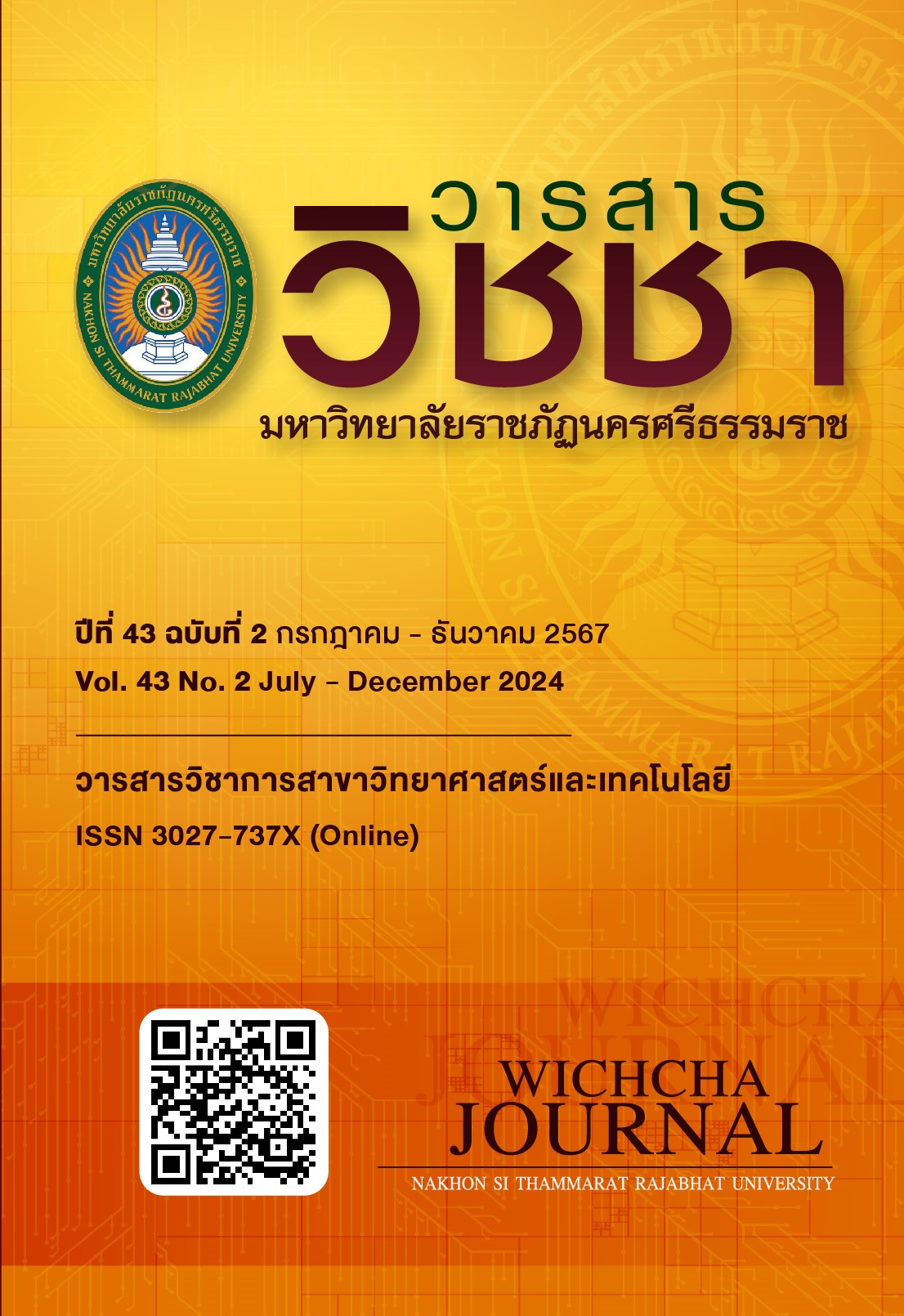Antioxidant Activities of Boesenbergia rotunda (L.) Mansf. Fermented with Lactic Acid Bacteria
Main Article Content
Abstract
This research aimed to study the antioxidant activities of Boesenbergia rotunda (L.) Mansf., known as fingerroot, fermented with probiotic lactic acid bacteria (LAB). Ten strains of lactic acid bacteria including Lactobacillus pentosus JM085, L. pentosus JM0812, L. pentosus UM055, L. pentosus UM054, L. pentosus YM122, L. pentosus VM096, L. pentosus DM068, L. pentosus VM095, Enterococcus faecalis YM126, and L. lactis A7 were used as starter culture for B. rotunda (L.) Mansf. Fermentation was at 0, 24, 48, and 72 hours. The results showed that the antioxidant activities depended on strains and fermentation time. The antioxidant capacity of fermented B. rotunda extract increased significantly (p ≤ 0.05) when fermentation time increased, using DPPH radical-scavenging assay (DPPH) and ferric reducing antioxidant power (FRAP) assay. The strongest DPPH scavenging capacity was observed in the sample fermented with L. pentosus DM068 at 72 hours (83.42±1.30 µg TE/ml), while FRAP reported in L. pentosus VM095, at 72 hours (295.82±2.15 µg Fe(II)/ml). In conclusion, probiotic lactic acid bacteria fermentation increased the antioxidant activities of B. rotunda extract. Applying the fermentation process for value addition in the food and pharmaceutical industries might be interesting.
Article Details

This work is licensed under a Creative Commons Attribution-NonCommercial-NoDerivatives 4.0 International License.
เนื้อหาและข้อมูลในบทความที่ลงตีพิมพ์ในวารสารวิชชา มหาวิทยาลัยราชภัฏนครศรีธรรมราช ถือเป็นข้อคิดเห็นและความรับผิดชอบของผู้เขียนบทความโดยตรง ซึ่งกองบรรณาธิการวารสารไม่จำเป็นต้องเห็นด้วยหรือร่วมรับผิดชอบใด ๆ
บทความ ข้อมูล เนื้อหา รูปภาพ ฯลฯ ที่ได้รับการตีพิมพ์ในวารสารวิชชา มหาวิทยาลัยราชภัฏนครศรีธรรมราช ถือเป็นลิขสิทธ์ของวารสารวิชชา มหาวิทยาลัยราชภัฏนครศรีธรรมราช หากบุคคลหรือหน่วยงานใดต้องการนำข้อมูลทั้งหมดหรือส่วนหนึ่งส่วนใดไปเผยแพร่ต่อหรือเพื่อการกระทำการใด ๆ จะต้องได้รับอนุญาตเป็นลายลักษณ์อักษรจากวารสารวิชชา มหาวิทยาลัยราชภัฏนครศรีธรรมราชก่อนเท่านั้น
The content and information in the article published in Wichcha journal Nakhon Si Thammarat Rajabhat University, It is the opinion and responsibility of the author of the article. The editorial journals do not need to agree. Or share any responsibility.
References
ทศพล พลคำมาก ธีระ ฤทธิรอด และสิรินดา ยุ่นฉลาด. (2559). การเพิ่มฤทธิ์ต้านอนุมูลอิสระของน้ำพลูคาวด้วยการผสมกับกระชายดำและหมักด้วยแบคทีเรียกรดแลคติก. วารสารวิจัย มข. (ฉบับบัณฑิตศึกษา), 16(1), 64-76.
ลัญจกร จันทร์อุดม นุชวรา องศารา ดาวีณาร์ ยีเลาะ และสุไรดา มามะแตหะ. (2559). การเปลี่ยนแปลงทางเคมีและจุลชีววิทยาของผลิตภัณฑ์ปอเยาะทุเรียนระหว่างการหมัก, วารสารวิชชา มหาวิทยาลัยราชภัฏนครศรีธรรมราช, 35(2), 1-15.
Baharudin, M.K.A., Hamid, S.A. and Susanti, D. (2015). Chemical composition and antibacterial activity of essential oils from three aromatic plants of the Zingiberaceae family in Malaysia. Journal of Physical Science, 26(1), 71-81.
Bakar, M.F.A., Mohamed, M., Rahmat, A. and Fry, J. (2009). Phytochemicals and antioxidant activity of different parts of bambangan (Mangifera pajang) and tarap (Artocarpus odoratissimus). Food Chemistry, 113(2), 479-483, doi: https://doi.org/10.1016/j.foodchem.2008.07.081.
Chaiyasut, C., Kusirisin, W., Lailerd, N., Lerttrakarnnon, P., Suttajit, M. and Srichairatanakool, S. (2011). Effects of phenolic compounds of fermented Thai indigenous plants on oxidative stress in streptozotocin-induced diabetic rats. Evidence-Based Complementary and Alternative Medicine, 2011, doi: https://doi.org/10.1155/2011/749307.
Ching, A.Y.L., Wah, T.S., Sukari, M.A., Lian, G.E.C., Rahmani, M. and Khalid, K. (2007). Characterization of flavonoid derivatives from Boesenbergia rotunda (L.). Malaysian Journal of Analytical Sciences, 11(1), 154-159.
Chong, T.E., Teck, F.G., Ming, W.S., Rahman, N.A., Khalid, N., Karsani, S.A. and Yusof, R. (2011). Optimization of two-dimensional gel electrophoresis protocols for Boesenbergia rotunda in vitro suspension culture. Journal of Medicinal Plants Research, 5(16), 3777-3780.
Chuakul, W. and Boonpleng, A. (2003). Ethnomedical uses of Thai Zingiberaceous plant. Journal Medicine, 10(1), 33-39.
Fooks, L.J., Fuller, R. and Gibson, G.R. (1999) Prebiotics, probiotics and human gut microbiology. International Dairy Journal, 9(1), 53-61, doi: https://doi.org/10.1016/S0958-6946(99)00044-8.
Itsaranuwat, P., Al-Haddad, K.S.H. and Robinson, R.K. (2003). The potential therapeutic benefits of consuming ‘health-promoting’ fermented dairy products: A brief update. International Journal of Dairy Technology, 56(4), 203-210, doi: https://doi.org/10.1046/j.1471-0307.2003.00106.x.
Jing, L.J., Bakar, M.F.A., Mohamed, M. and Rahmat, A. (2010). Effects of selected Boesenbergia species on the proliferation of several cancer cell lines. Journal of Pharmacology and Toxicology, 6(3), 272-282, doi: https://doi.org/10.3923/jpt.2011.272.282.
Kechagia, M., Basoulis, D., Konstantopoulou, S., Dimitriadi, D., Gyftopoulou, K., Skarmoutsou, N. and Fakiri, E.M. (2013). Health benefits of probiotics: A review. International Scholarly Research Notices, 2013, doi: https://doi.org/10.5402/2013/481651.
Morikawa, T., Funakoshi, K., Ninomiya, K., Yasuda, D., Miyagawa, K., Matsuda, H. and Yoshikawa, M. (2008). Medicinal foodstuffs. XXXIV. structures of new prenylchalcones and prenylflavanones with TNF-α and aminopeptidase N inhibitory activities from Boesenbergia rotunda. Chemical and Pharmaceutical Bulletin, 56(7), 956-962, doi: https://doi.org/10.1248/cpb.56.956.
Pesewu, G.A., Cutler, R.R. and Humber, D.P. (2008). Antibacterial activity of plants used in traditional medicines of Ghana with particular reference to MRSA. Journal of Ethnopharmacology, 116(1), 102-111, doi: https://doi.org/10.1016/j.jep.2007.11.005.
Riswan, S. and Sangat-Roemantyo, H. (2002). Jamu as traditional medicine in java, Indonesia. South Pacific Study, 23(1), 1-10.
Salguero, C.P. (2003). A Thai herbal: Traditional recipes for health and harmony. Retrieved 4 June 2024, from: https://thaihealingalliance.com/wp-content/uploads/The_Theory_of_Royal_Thai_medicine.pdf.
Sawangwan, T., Porncharoennop, C. and Nimraksa, H. (2021). Antioxidant compounds from rice bran fermentation by lactic acid bacteria. AIMS Agriculture and Food, 6(2), 578-587, doi: https://doi.org/10.3934/agrfood.2021034.
Shori, A.B. (2013). Antioxidant activity and viability of lactic acid bacteria in soybean-yogurt made from cow and camel milk. Journal of Taibah University for Science, 7(4), 202-208, doi: https://doi.org/10.1016/j.jtusci.2013.06.003.
Yusuf, N.A., Annuar, M.S.M. and Khalid, N. (2013). Existence of bioactive flavonoids in rhizomes and plant cell cultures of Boesenbergia rotunda (L.) Mansf. Kulturpfl. Australian Journal of Crop Science, 7(6), 730-734.
Zhang, L., Tu, Z.C., Yuan, T., Wang, H., Xie, X. and Fu, Z.F. (2016). Antioxidants and α-glucosidase inhibitors from Ipomoea batatas leaves identified by bioassay-guided approach and structure-activity relationships. Food Chemistry, 208, 61-67, doi: https://doi.org/10.1016/j.foodchem.2016.03.079.

